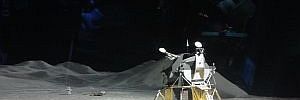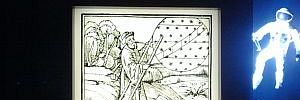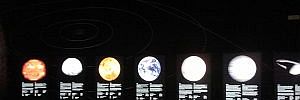Deutsche Version | Wiki Start | Topics Collection v
Creation - The Fourth Day ...
Friday, Aug 9, 2013. We are reading the creation story following the biblical book “Genesis”, the first book of Moses. Creation is described in several days, starting with the creation of light and darkness on day one, heaven and earth on day two, the oceans and the land with plants and trees on day three. Let us read what happens next according to Genesis 1:
The fourth day …
14 And God said, “Let there be
lights
in the expanse of the heavens to separate the day from the night. And let them be for signs and for seasons,6 and for days and years, 15 and let them be lights in the expanse of the heavens to give light upon the earth.” And it was so. 16 And God made the two great lights— the greater light to rule the day and the lesser light to rule the night—and the stars. 17 And God set them in the expanse of the heavens to give light on the earth, 18 to rule over the day and over the night, and to separate the light from the darkness. And God saw that it was good. 19 And there was evening and there was morning, the fourth day. (Gen 1, 9-13) The activities on day four go back to the large picture, to the appearance of the sky as seen from the earth. We hear that God creates the stars - the lights in the heaven, to separate day from night. It is also talked about the sun (as the light of the day) and the moon (as the light of the night). At this point you might ask yourself: what is the order in which things have been created. On the first day, when light and darkness has been created, does this mean to creat the sun already? Does it mean that the galaxies with their individual suns, the planets and the whole universe has been there already? What about the creation of the stars and the sun and the moon on day four? There are two main arguments about this, which I would like to describe. Creation in what order? …**
Day two speaks about the heavens and the earth already, day three about land and water, about plants and trees. So this assumes the earth to be there. Even the “evening and morning” of the first day indicates the earth rotation already. But that means that the universe was created at the beginning.
Here, it is said that God “made” the two lights, which are without doubt the sun and the moon, to give light during day and night. The question is: does this necessarily mean that the sun and moon are created on the fourth day? Or does it mean that they became visible on the fourth day. We know that the earth atmosphere changed many times during the evolution of the earth. The visible window for light and near-infrared radiation and various microwave frequencies is strongly dependent on the chemical composition of the atmosphere. When we hear: he made a light for the day and a light for the night, - or when it is said: “let there be lights” - then this could well refer to the fact that the earth atmosphere became transparent for visible light (400-700 nm wavelength), such that the sun and the moon became visible on the earth. This would lead to a consistent setup such that “the lights” have been made after the plants and the trees (which by their production of oxygen changed the atmospheric chemistry, a well-known fact today).
There is another community of scholars, which does not try to put this creation story into a realistic framework at all. If the story about creation ist just giving us a story, which reflects the belief of people which did not have the natural insight we have today, then your approach will be different, of course. You might not ask for the description of reality, but for the psychological components of the message - an approach which we could also add onto our more realistic reading of these ancient text. (Roland Potthast) ... more texts





